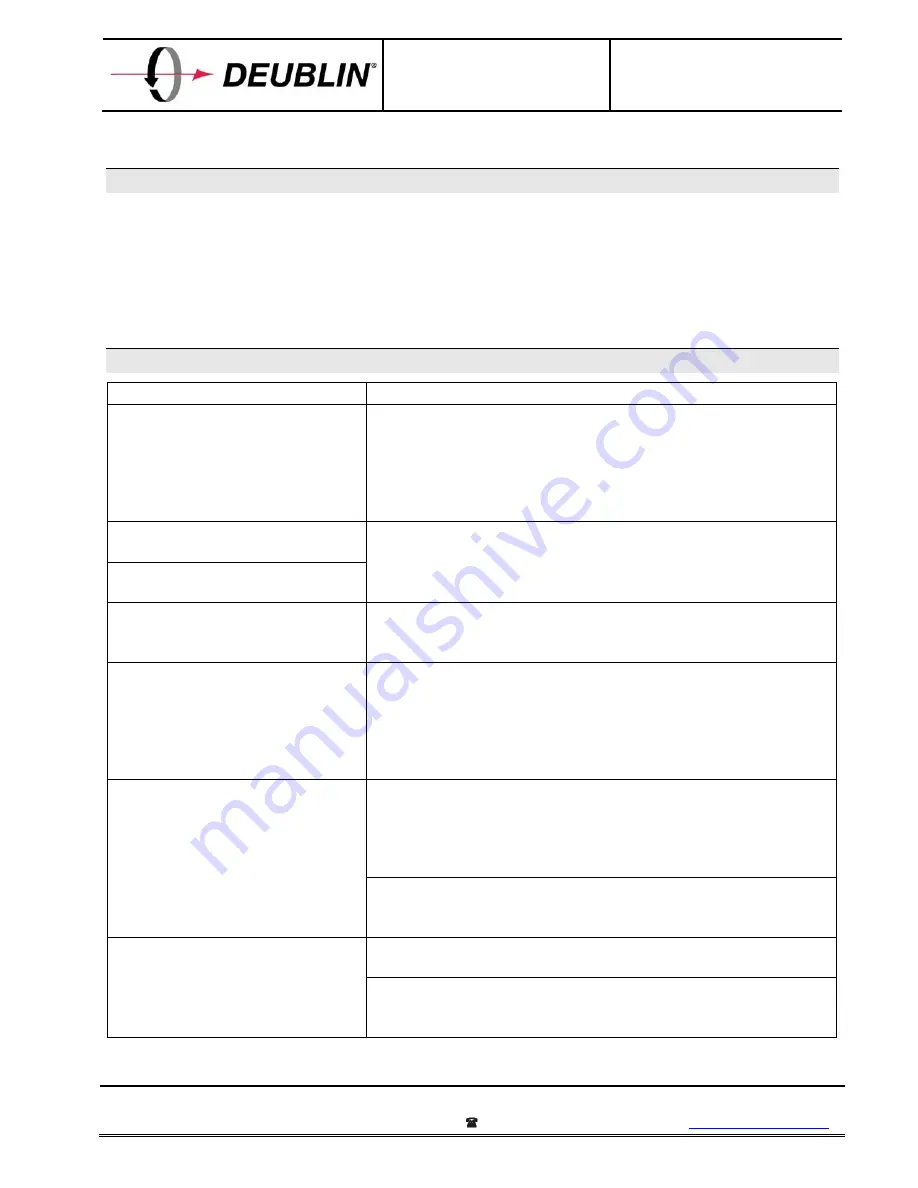
Instruction Manual
for
DEUBLIN
Bore-Mounted
Two-Channel Rotating Unions
Model/Series:
1112-240-001
Number:
Release: 275 V
Page 9 of 11
DEUBLIN Company • 2050 Norman Drive • Waukegan IL 60085-6747 USA • +1-847-689-8600 •
+1-847-689-8690 •
Preventing Premature Seal Failure
During tool change, most machining centers supply air flow to keep the taper of the drawbar mechanism clean.
When this air flow is supplied through the union and the new tool is “dead-ended” (i.e., not designed for
through-spindle coolant), air pressure may become trapped between the new tool and the check valve in the
air line, thereby keeping the Pop-Off™ seal faces closed. Subsequent spindle rotation without coolant will
cause overheating and premature failure of the seals. To avoid this, trapped air must be vented. Consult
Deublin for assistance on how best to do this in your application.
Troubleshooting
Problem Solution
Union temperature seems too high
immediately after installation.
Operating temperature may be higher than normal immediately after
installing the union, especially if the union is used immediately at
high RPMs without media. Generally, it is a good idea to “run in” a
new union in order to evenly distribute grease in the bearings. The
union will operate correctly without being run in, but it will run hot
for a little while.
Union temperature persistently
exceeds 50°C (122°F) after run-in.
Union makes a loud squeaking or
chirping noise at higher RPMs.
The seals may be running dry and probably are damaged. This can
happen, for example, if air for cleaning the tool taper blows through
the spindle and trapped pressure is not released after the tool
change. The union should be replaced immediately.
Union makes a loud buzzing or
rattling noise at higher RPMs.
The bearings may be damaged. This can happen when the drain
hose is blocked or does not have a continuous downward slope.
The union should be replaced immediately.
A few milliliters of coolant flow
from the drain hose at the beginning
of each tool change.
This is normal. Pop-Off™ seals close when coolant pressure is
applied and open when pressure is removed. After using through-
spindle coolant, media remaining in the spindle and supply hose
will drain out from the union. This feature eliminates friction and
seal wear during operation without coolant, and allows unlimited
“dry running” at any speed.
Media pressure and flow are insufficient to close the seals. Media
pressure at the union must be at least 1.5 bar to close the seals, with
an initial flow of at least 1.5 L/min. Measure media pressure at the
coolant supply connection and increase system pressure as
necessary.
Coolant flows from the drain hose
for several seconds, or more, after
coolant pressure is turned on, then
stops eventually.
Contaminants in the media are jamming the seals and preventing
proper closing. Check the filtration system and replace the filter as
necessary.
The seals have been damaged or have reached the end of their
useful life. The union should be replaced immediately.
Coolant flows continuously from
the drain hose during operation with
through-spindle coolant.
Media pressure and flow are insufficient to close the seals. Media
pressure at the union must be at least 1.5 bar to close the seals, with
a flow of at least 1.5 L/min.











